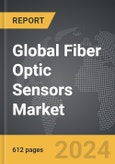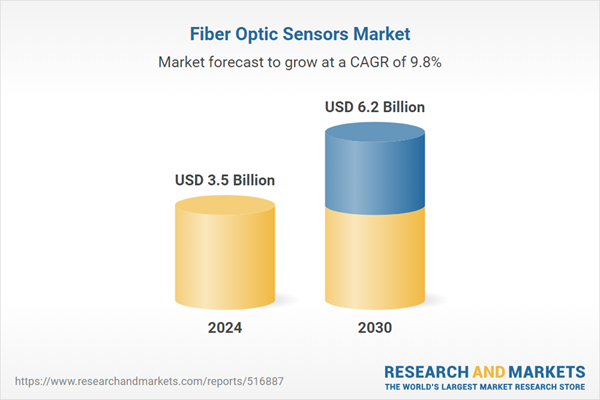The global market for Fiber Optic Sensors was valued at US$3.5 Billion in 2024 and is projected to reach US$6.2 Billion by 2030, growing at a CAGR of 9.8% from 2024 to 2030. This comprehensive report provides an in-depth analysis of market trends, drivers, and forecasts, helping you make informed business decisions. The report includes the most recent global tariff developments and how they impact the Fiber Optic Sensors market.
Segments: Product Type (Intrinsic Fiber Optic Sensors, Extrinsic Fiber Optic Sensors); End-Use (Oil & Gas End-Use, Industrial End-Use, Infrastructure End-Use, Security End-Use, Other End-Uses).
Geographic Regions/Countries: World; USA; Canada; Japan; China; Europe; France; Germany; Italy; UK; Spain; Russia; Rest of Europe; Asia-Pacific; Australia; India; South Korea; Rest of Asia-Pacific; Latin America; Argentina; Brazil; Mexico; Rest of Latin America; Middle East; Africa.
The analysts continuously track trade developments worldwide, drawing insights from leading global economists and over 200 industry and policy institutions, including think tanks, trade organizations, and national economic advisory bodies. This intelligence is integrated into forecasting models to provide timely, data-driven analysis of emerging risks and opportunities.
Global Fiber Optic Sensors Market - Key Trends & Drivers Summarized
What Are Fiber Optic Sensors and Why Are They Pioneering Sensing Technologies?
Fiber optic sensors are advanced sensing devices that utilize optical fibers to measure various physical parameters such as temperature, pressure, strain, and displacement. These sensors operate by detecting changes in light properties - such as intensity, wavelength, or phase - when transmitted through the fiber. Their unique advantages, including immunity to electromagnetic interference, high sensitivity, and the ability to function in harsh environments, make them indispensable in applications ranging from industrial automation to medical diagnostics. As industries increasingly demand precise and reliable data collection, fiber optic sensors have emerged as a critical technology driving innovation in sensing solutions.How Are Technological Advancements Shaping the Capabilities of Fiber Optic Sensors?
The rapid evolution of technology has significantly enhanced the performance and versatility of fiber optic sensors. Innovations in fiber Bragg grating (FBG) technology have enabled the development of highly sensitive sensors that can measure multiple parameters simultaneously. Miniaturization of components has allowed for the creation of compact sensors suitable for applications in constrained spaces, such as medical catheters or structural monitoring of aerospace components. Integration with digital technologies, such as real-time data acquisition systems and machine learning algorithms, has improved signal interpretation and predictive maintenance capabilities. Moreover, advancements in multiplexing techniques now enable the deployment of hundreds of sensors on a single fiber, reducing installation costs and improving scalability.Which Industries Are Driving Adoption and What Applications Are Leading the Way?
Fiber optic sensors are finding widespread adoption across various industries due to their versatility and reliability. In the oil and gas sector, these sensors are used for pipeline monitoring, leak detection, and downhole temperature and pressure measurements. Civil engineering projects rely on them for structural health monitoring of bridges, tunnels, and dams to ensure safety and longevity. In the medical field, fiber optic sensors are employed for minimally invasive diagnostics, such as measuring internal body temperatures and monitoring physiological changes during surgeries. They are also extensively used in the aerospace and defense sectors for vibration and stress monitoring in aircraft and military equipment. Emerging applications in renewable energy, such as wind turbine condition monitoring, are further expanding their reach.What Are the Key Drivers Propelling the Growth of the Fiber Optic Sensors Market?
The growth in the fiber optic sensors market is driven by several factors, including technological advancements, increasing demand for precise monitoring solutions, and expanding applications across industries. Rising infrastructure development and the need for reliable structural health monitoring systems have significantly boosted adoption. The oil and gas sector's focus on enhancing operational safety and efficiency has increased the demand for advanced sensing technologies. In healthcare, the trend toward minimally invasive diagnostic tools is fueling the use of fiber optic sensors. Additionally, the global push for renewable energy and sustainable practices has created opportunities for fiber optic sensors in environmental monitoring and energy systems. Advancements in sensor multiplexing, ruggedized designs for harsh environments, and cost reductions in manufacturing are also driving growth. Moreover, supportive government regulations and investments in smart infrastructure are further accelerating market expansion.Report Scope
The report analyzes the Fiber Optic Sensors market, presented in terms of units. The analysis covers the key segments and geographic regions outlined below.Segments: Product Type (Intrinsic Fiber Optic Sensors, Extrinsic Fiber Optic Sensors); End-Use (Oil & Gas End-Use, Industrial End-Use, Infrastructure End-Use, Security End-Use, Other End-Uses).
Geographic Regions/Countries: World; USA; Canada; Japan; China; Europe; France; Germany; Italy; UK; Spain; Russia; Rest of Europe; Asia-Pacific; Australia; India; South Korea; Rest of Asia-Pacific; Latin America; Argentina; Brazil; Mexico; Rest of Latin America; Middle East; Africa.
Key Insights:
- Market Growth: Understand the significant growth trajectory of the Intrinsic Fiber Optic Sensors segment, which is expected to reach US$4.5 Billion by 2030 with a CAGR of a 10.9%. The Extrinsic Fiber Optic Sensors segment is also set to grow at 7.0% CAGR over the analysis period.
- Regional Analysis: Gain insights into the U.S. market, valued at $1.1 Billion in 2024, and China, forecasted to grow at an impressive 13.0% CAGR to reach $869.2 Million by 2030. Discover growth trends in other key regions, including Japan, Canada, Germany, and the Asia-Pacific.
Why You Should Buy This Report:
- Detailed Market Analysis: Access a thorough analysis of the Global Fiber Optic Sensors Market, covering all major geographic regions and market segments.
- Competitive Insights: Get an overview of the competitive landscape, including the market presence of major players across different geographies.
- Future Trends and Drivers: Understand the key trends and drivers shaping the future of the Global Fiber Optic Sensors Market.
- Actionable Insights: Benefit from actionable insights that can help you identify new revenue opportunities and make strategic business decisions.
Key Questions Answered:
- How is the Global Fiber Optic Sensors Market expected to evolve by 2030?
- What are the main drivers and restraints affecting the market?
- Which market segments will grow the most over the forecast period?
- How will market shares for different regions and segments change by 2030?
- Who are the leading players in the market, and what are their prospects?
Report Features:
- Comprehensive Market Data: Independent analysis of annual sales and market forecasts in US$ Million from 2024 to 2030.
- In-Depth Regional Analysis: Detailed insights into key markets, including the U.S., China, Japan, Canada, Europe, Asia-Pacific, Latin America, Middle East, and Africa.
- Company Profiles: Coverage of players such as Avantes B.V., Banner Engineering Corp., Baumer Group, Davidson Instruments, Inc. and more.
- Complimentary Updates: Receive free report updates for one year to keep you informed of the latest market developments.
Some of the 172 companies featured in this Fiber Optic Sensors market report include:
- Avantes B.V.
- Banner Engineering Corp.
- Baumer Group
- Davidson Instruments
- Inc.
- EXFO Inc.
- Halliburton
- Honeywell Process Solutions
- Intelligent Fiber Optics Systems Corp.
- Keysight Technologies
- Inc.
- KVH Industries
- Inc.
- LUNA Innovations Incorporated
- Northrop Grumman Corporation
- O/E LAND Inc.
- Ocean Optics
- Inc.
- Omron Industrial Automation
- Optrand, Inc.
- Prysmian S.p.A.
- Roctest Ltd.
- Schlumberger Limited
- Sensornet Ltd.
- Sensuron LLC
- Weatherford International plc
- Yokogawa Electric Corporation
Tariff Impact Analysis: Key Insights for 2025
Global tariff negotiations across 180+ countries are reshaping supply chains, costs, and competitiveness. This report reflects the latest developments as of April 2025 and incorporates forward-looking insights into the market outlook.The analysts continuously track trade developments worldwide, drawing insights from leading global economists and over 200 industry and policy institutions, including think tanks, trade organizations, and national economic advisory bodies. This intelligence is integrated into forecasting models to provide timely, data-driven analysis of emerging risks and opportunities.
What’s Included in This Edition:
- Tariff-adjusted market forecasts by region and segment
- Analysis of cost and supply chain implications by sourcing and trade exposure
- Strategic insights into geographic shifts
Buyers receive a free July 2025 update with:
- Finalized tariff impacts and new trade agreement effects
- Updated projections reflecting global sourcing and cost shifts
- Expanded country-specific coverage across the industry
Table of Contents
I. METHODOLOGYII. EXECUTIVE SUMMARY2. FOCUS ON SELECT PLAYERSIII. MARKET ANALYSISJAPANCHINAFRANCEGERMANYITALYUNITED KINGDOMSPAINRUSSIAREST OF EUROPEAUSTRALIAINDIASOUTH KOREAREST OF ASIA-PACIFICLATIN AMERICAARGENTINABRAZILMEXICOREST OF LATIN AMERICAMIDDLE EASTAFRICAIV. COMPETITION
1. MARKET OVERVIEW
3. MARKET TRENDS & DRIVERS
4. GLOBAL MARKET PERSPECTIVE
UNITED STATES
CANADA
EUROPE
ASIA-PACIFIC
Companies Mentioned (Partial List)
A selection of companies mentioned in this report includes, but is not limited to:
- Avantes B.V.
- Banner Engineering Corp.
- Baumer Group
- Davidson Instruments
- Inc.
- EXFO Inc.
- Halliburton
- Honeywell Process Solutions
- Intelligent Fiber Optics Systems Corp.
- Keysight Technologies
- Inc.
- KVH Industries
- Inc.
- LUNA Innovations Incorporated
- Northrop Grumman Corporation
- O/E LAND Inc.
- Ocean Optics
- Inc.
- Omron Industrial Automation
- Optrand, Inc.
- Prysmian S.p.A.
- Roctest Ltd.
- Schlumberger Limited
- Sensornet Ltd.
- Sensuron LLC
- Weatherford International plc
- Yokogawa Electric Corporation
Table Information
| Report Attribute | Details |
|---|---|
| No. of Pages | 665 |
| Published | April 2025 |
| Forecast Period | 2024 - 2030 |
| Estimated Market Value ( USD | $ 3.5 Billion |
| Forecasted Market Value ( USD | $ 6.2 Billion |
| Compound Annual Growth Rate | 9.8% |
| Regions Covered | Global |









